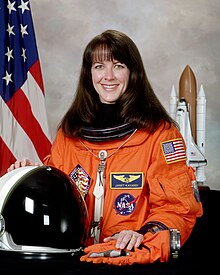Janet L. Kavandi
| Janet Lynn Kavandi | |
|---|---|
 |
|
| NASA Former Astronaut | |
| Nationality | American |
| Status | Retired |
| Born |
July 17, 1959 Carthage, Missouri |
|
Other occupation
|
Chemist |
|
Time in space
|
33d 20h 08m |
| Selection | 1994 NASA Group |
| Missions | STS-91, STS-99, STS-104 |
|
Mission insignia
|
|
Janet Lynn Kavandi, a native of Carthage, Missouri, (born July 17, 1959) is an American scientist and a NASA astronaut. She is a veteran of three Space Shuttle missions and has served as NASA's Deputy Chief of the Astronaut Office.
Kavandi graduated Valedictorian in 1977 from Carthage Senior High School - Carthage, Missouri. She went on to earn degrees in chemistry from Missouri Southern State College (bachelor's, 1980), the Missouri University of Science and Technology (masters, 1982), and the University of Washington (doctorate, 1990).
Following graduation in 1982, Kavandi accepted a position at Eagle-Picher Industries in Joplin, Missouri, as an engineer in new battery development for defense applications. In 1984, she accepted a position as an engineer in the Power Systems Technology Department of Boeing Defense, Space & Security in Seattle, Washington. She served as lead engineer of secondary power for the Short Range Attack Missile II, and principal technical staff representative involved in the design and development of thermal batteries for Sea Lance and the Lightweight Exo-Atmospheric Projectile. Other programs she supported include Space Station, Lunar and Mars Base studies, Inertial Upper Stage, Advanced Orbital Transfer Vehicle, Get-Away Specials, Air Launched Cruise Missile, Minuteman, and Peacekeeper. In 1986, while still working for Boeing, she was accepted into graduate school at the University of Washington, where she began working toward her doctorate in analytical chemistry. Her doctoral dissertation involved the development of a pressure-indicating coating that uses oxygen quenching of porphyrin photoluminescence to provide continuous surface pressure maps of aerodynamic test models in wind tunnels. Her work on pressure indicating paints has resulted in two patents.
...
Wikipedia
